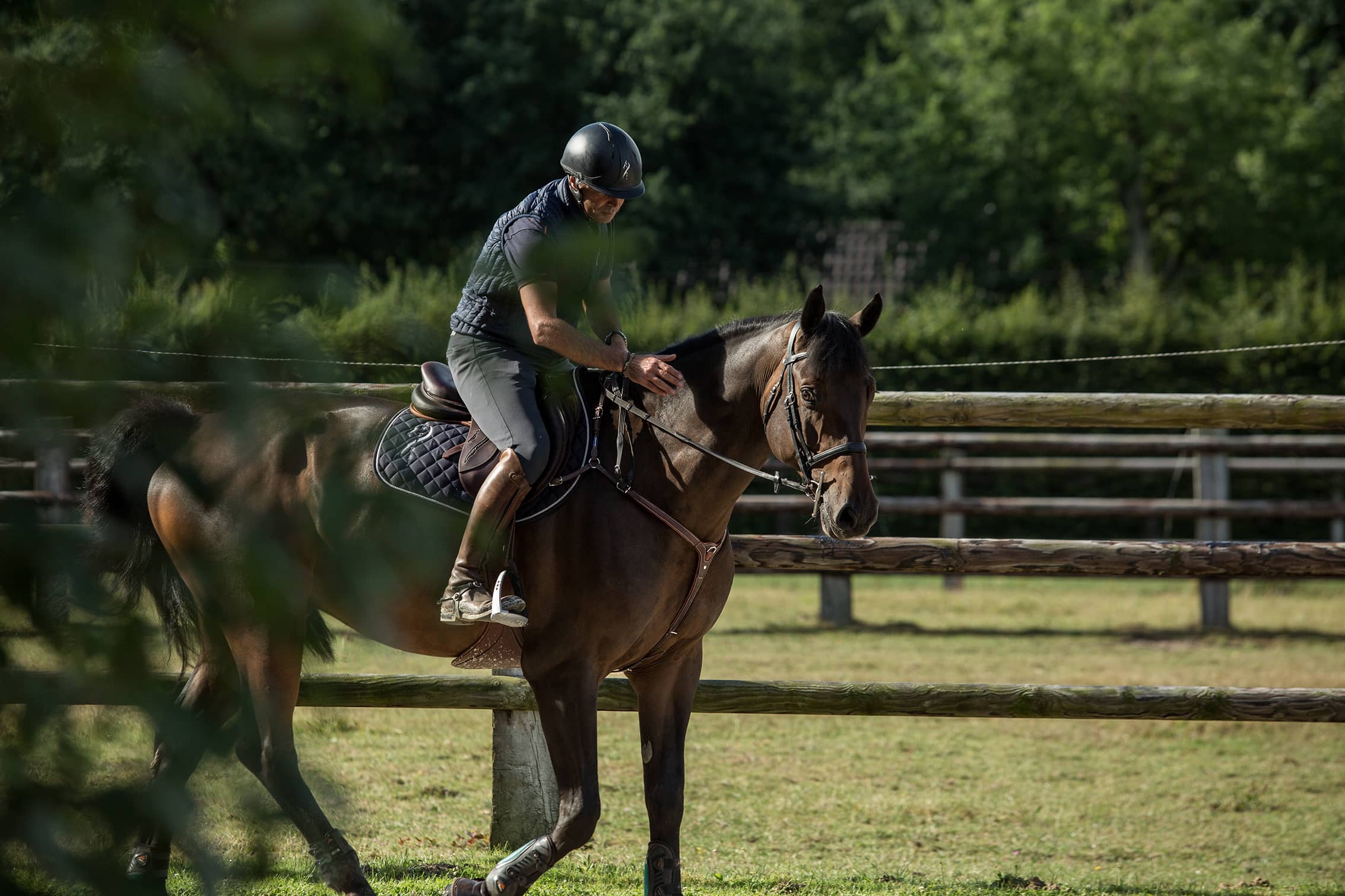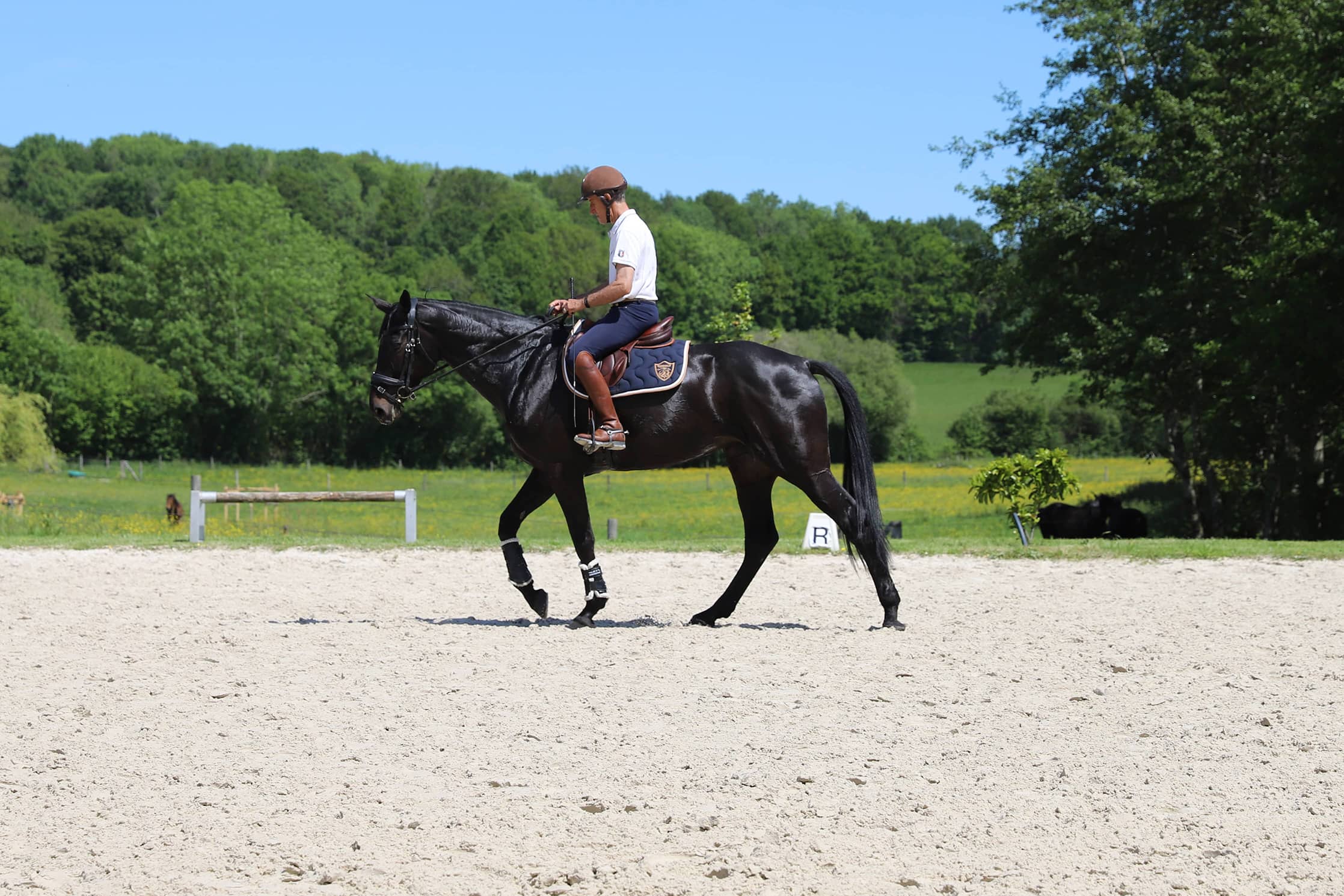Advice
Stretching: What stretching exercises can do with your horse?
25 July 2022

Advice
25 July 2022

You probably hear the term stretching exercises quite often. A stretching session is perfect to help a horse recover after a workout (and let’s be honest, for the rider too) and highly recommended for many reasons. It helps improve balance or working in comfort, and so on but what’s really behind the term “stretching”? What exercises should you do with your horse? When? We’ll answer all these questions!
Stretching flexes the muscles laterally and lengthwise. The aim is to work on your horse’s posture in a relaxed manner. Your horse must be positioned low enough to see its natural balance.
Stretching exercises are not meant to build up your horse’s muscles. While muscle-building does require muscle contractions, this doesn’t always apply to stretching. It all depends on what types of exercises you want to do.
Never forget about impetus when you do your exercises. Although stretching exercises are done when the body is more relaxed and sometimes at a slower pace, the key is keeping the hind quarters engaged. Your horse must remain active and responsive, so don’t confuse stretching with slackness or laxity.
In theory, stretching can therefore suit all horses. That said, bear in mind your horse’s physical condition and the point it has reached when working out.

Yes, if the exercises are properly done, they do suit all horses. Stretching helps competition horses to perfect their posture and improve performance. It also provides comfort or soothes specific pains for older horses, or those in physiotherapy.
For competition horses, a stretching session is the perfect thing to do the day after an event. It drastically reduces aches brought on by competing the day before. Yet, stretching exercises are also great to do before or after a workout or event. Done beforehand, they help your horse keep its topline firm and to work better. This way, it’s ready for the workout to come. After a workout or event, stretching exercises help your horse to recover.
You should be plan stretching sessions regularly for older horses. They help (early) retired horses keep fit and healthy and in good shape generally.
Also, given current events, stretching is ideal for hot summer days. It takes less out of your horse, so keeping them fit and healthy when they do work out. If you want more tips on to provide your horse with some relief during heatwaves, take a look at our article on the subject.
. This is a key stage but often overlooked to save time. Walking your horse to relax it is vital so that it is in the right shape for its stretching session. We suggest, if possible, that you walk your horse outside (ideally) for 15 to 20 minutes. Obviously, your horse’s neck should be horizontal. If your reins are long enough, your horse may well dip his neck towards the ground. This is the perfect position to do some back stretches.
We also stress that walks outside hugely improve the mood of both horse and rider. So, don’t skimp, take the time!
If you can’t go outside, attach a lead rope and walk your horse. This should be done with the reins removed so that your horse can move freely and warm up without carrying the weight of a rider on its back.


A horse cantering or galloping with his head down is a relatively natural posture, yet quite a rare sight in its natural surroundings. Neck stretches have many benefits:
However, there are pitfalls to these which riders sometimes forget. Neck stretches can overload the forequarters, putting the horse off-balance. You should adapt how much you stretch your horse’s neck to its natural balance.
Also, even if the tip of your horse’s nose goes forward and then down, make sure you don’t let go of it. You must have a hold on your horse at all times even if you let your reins out.
Read the article on Pamfou Dressage for further information on neck stretches.
Whether switching between two gaits or in the same gait, transitions must be steady and stable. The aim is not to step up the pace when a horse drops its shoulders, leaning and trying to accelerate. In fact, the opposite is true. You should keep the same posture when changing pace with a horse that leans forward, without pulling on its bit.
To do this, the rider has to learn to give some slack at the right time. That way, the horse regains the right posture while the rider moves their hands forward to compensate.
Don’t forget the principle of impetus. Successive transitions should help your horse become livelier and lower their hips at each downward transition.
Stretching exercises done while doing lateral workouts are more comprehensive that longitudinal muscle stretches. They involve stretching the shoulders and hips laterally while making forward movements. However, longitudinal and lateral muscle stretches are complementary. It is perfectly possible (and even recommended, always according to how far your horse is into its training session) to combine both. By making transitions when doing incurvation training while riding your horse in a circle, for example.
This is defined as bending the horse’s entire spine in an arc, from head to tail. The horse must curve its body without falling into the circle. The far side of the horse is stretched while the near side is contracted and tight to different degrees based on the level of lateral bending.
You can do the following figures to work on your horse’s lateral bending:
By slightly bending its neck, your horse moves by crossing its legs. The horse’s posture is generally not as low compared to lateral bending training or transitions as this exercise requires more movement and physical effort.
Remember to work on this exercise very gradually. In nature, a horse hardly uses its abductor and adductor muscles, so, you’ve got to be patient.
This is a fool proof stretching exercise where the horse moves on three tracks while bending its ribcage around the rider’s inside leg. In a slightly curved position, your horse uses its shoulders on the inside track while its hips stay on-track.
While this clearly provides greater flexibility in the shoulders, it also flexes a relatively rigid part of the horses vertebral column called the dorsal vertebra of the withers.
Aside from stretching, this exercise also engages the hindquarters.
Just like leg yielding, shoulder-in exercises work on the abductor and adductor muscles.
For a more intensive shoulder-in workout, see the IFCE article on this subject.


Stretching reaps rewards for relaxing and loosening up your horse, as well providing greater balance and suppleness. By doing longitudinal and lateral stretching exercises, you’ll also gain greater control of your horse’s hips and shoulders. Remember, though, to keep to your horse’s rhythm when exercising. Stretching exercises may be more of less difficult to conduct based on its body shape and condition. Remember that a relaxed horse isn’t necessarily one that has less impulsion. If there’s a lack of tempo, this may reduce the efforts made in your stretching session. Finally, if your horse shows some resistance during the stretching session, it is probably not yet ready for the exercise or that your assistance is too arduous. Taking more time, makes an exercise easier. Sometimes you have to take a step back to make a big jump forwards (or stretch, in this case).